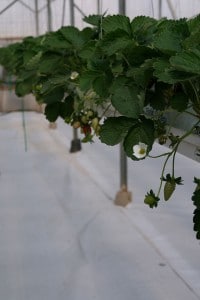By Mark Benedetti | Contributing Writer
Deep beneath Hunt Hall there is a bunker-like structure with cool, brick tunnels that lead to an underground scientific laboratory run by a select group of professors and their students. They are spearheading a new technology that they hope will change the world, from the biomedical to the food we eat in Miley. It is Salve Regina’s hydroponics research lab.
Hydroponics is a form of agriculture where plants are grown without the use of soil; instead they are suspended in water. The practice, while being the spark of a new agricultural revolution, can be traced back throughout the centuries. Chinampas, or floating gardens, amazed Spanish conquistadors as they entered Tenochtitlan during the height of the Aztec Empire. They sat peacefully throughout the lake that surrounded the ancient city in modern Mexico. However, today’s hydroponics are kept indoors, with artificial light and ventilation systems. The benefits of hydroponics are huge, as systems can be built vertically, possibly in a factory. This saves space and can bring local food a lot closer to densely populated cities, where gardening is difficult and farming is a complete impossibility.
There is no run off, so very little pollution enters the soil or water from things such as fertilizer or oil from a tractor, as in traditional agriculture. The water is a closed loop, so the precious resource very rarely has to be pumped in from the outside. Plant research is easy to conduct as well because variables can easily be controlled in a hydroponic lab, whereas many factors can influence the findings if the work is done outdoors. Plants grow faster hydroponically, and with just as many nutrients from a small organic farm. Maria Smith, ’16, is a lab research assistant who told me that we are “on the path to a new green revolution… because we have to be.”
I was lucky enough to secure a tour of the lab with Smith on a rainy day in early October. After reaching the room through the basement of Hunt Hall, one enters SRU’s lab by first removing their shoes to remove any contamination from bugs or dirt, with the option of continuing with socks on or sliding a pair of plastic booties over your feet. Passing through a plastic barrier, one then arrives in the data center. The data center has a computer where all of the information gathered from the lab is placed. Smith told me that there’s a plan in place to connect the computer to a database with other hydroponic labs, streamlining the research process for the groups involved. There is also a landline phone and a webcam to connect the team to other workers, building off of each other’s work.
Once I made it through the data center and a second plastic barrier, I entered to a bright white room where the first thing that strikes you is the scent of your grandmother’s kitchen, the strong aroma of basil. There are assorted towers and pipes throughout the room, circulating water and nutrients to the plants while lights shine down to make an artificial sun. The first set of plants that Smith brings me to is where young seeds are germinating. Seeds are placed into rock wool cubes, which are fibrous to create a place for the seedlings to grab hold and is also biodegradable. That’s important if they are to be transplanted into water, where the cube can then slowly disintegrate. To pump nutrients into the seedlings, an additive is added to the tray of cubes where a trickle of water is bringing supplements with a low ion concentration into the mix, speeding up the process.
After the plants grow to a sufficient size, they are either placed in a Tubular Grow System (TGS), or an Elevated Grow System (EGS), essentially mobile towers of the TGS. They are similar in that the structures hold plants in place while piping brings water and additives throughout the system, constantly recycling itself. The light systems they use are T5 fluorescent lights, T12 fluorescent lights (which adds the elusive blue light to the spectrum), and LED lights (the most efficient which gives off the most of the spectrum of light). The system also has a dehumidifier, which holds the power of life and death for the plants (due to the lack of natural weather), an air conditioner and lots of fans for ventilation so that plants can have some resistance to grow stronger, which in nature the wind usually provides. One corner has a tent that holds a very specific experiment being conducted by Shelby Johnson, ’16. The tent uses high pressure sodium light, giving off different wavelengths of light and a higher temperature. Johnson is working with the flowering bush Madagascar Periwinkle, Catharanthus roseus, to find how the plant grows hydroponically and traditionally. Her main research however is for vinchristine, a chemical compound which appears naturally in the plant. It is an alkaloid used in chemotherapy.
The most common thing people ask Smith after she mentions she works with hydroponics is why it is so much better than traditional agriculture. Smith tells me that there is very low water loss involved in the process, and that it has a low impact compared to large scale agriculture. There’s no fertilizer that can run off into a watershed, and it saves space. The little waste the lab creates is completed. Smith pushes for organics, as she finds that although it is slow, there are so many more minerals and vitamins humans can ingest than are found in inorganics which grow quicker (The lab does have a section dedicated to organics, however the lab as an entirety is not). I mentioned that staple crops, such as wheat, rice, and corn would be difficult to grow at this scale, to which Smith replied that there is ground breaking work going on currently that has the cash crops rice and cotton being grown in similar systems.
When I asked about the energy required for the lab, which I figured was quite a lot compared to traditional agriculture, Smith was quick to mention that the lab constantly monitors their electricity use, which surprisingly isn’t much. The lights do not require a lot of energy to run, and the water is mostly run through gravity. The naysayers to hydroponics often bring up the start-up capital required to run systems, especially for commercial gains. Truth be told, it is quite high. Smith, however, with a hint of pride, mentions that for $150 a person could purchase their own system for roughly fifteen plants, allowing gardening year round, from a farm house in Montana, to a loft in lower Manhattan (if a reader is interested Grow RI is the main supplier of SRU’s lab).
The SRU research lab practices a lot of outreach in order to get support from the outside. They have taken on a couple of interns from the Met school, and have also worked a lot in educating local schools on hydroponics. Zoe Moska, ’15, visits these schools to help set up and maintain hydroponic systems that the students can grow their own plants. Occasionally they’ll take the crops from SRU’s lab to a Farmers Market to sell, but mostly to educate the public on hydroponics. “Farming isn’t supposed to hurt the land,” Smith tells me in closing, “This, combined with medium organic farms, could be the future of agriculture.” The passion she speaks of for her work, and the pride she displays in this technology, made me confident that it very well could be one day.















